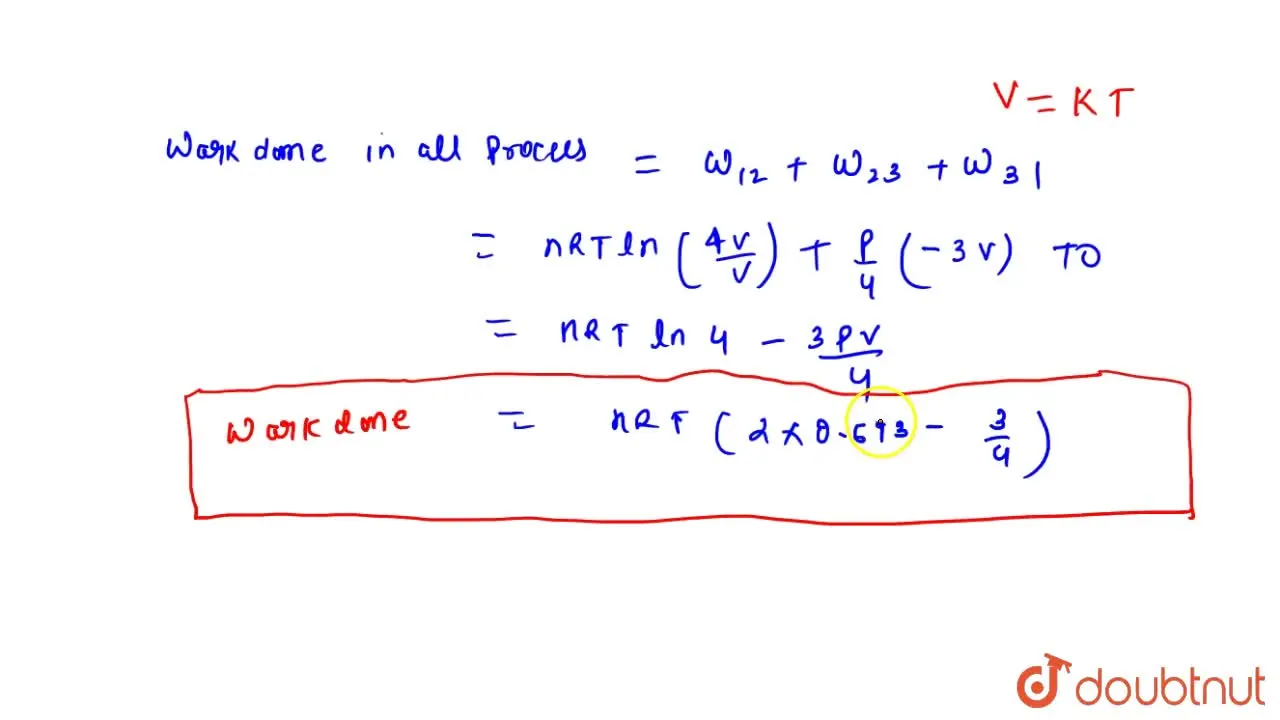An ideal gas intially has pressure P volume V and temperature T. Its is isothermally expanded to four times of its original volume, then it is compressed at constant pressure to attain its original volume V. Finally, the gas is heated at constant volume to get the original temperature T. (a) Draw V−T curve (b) Calculate the total work done by the gas in the process.(given ln2=0.693)
(a) V−T curve for all process is shown in figure. The initial state is represented by the point A. in the first step, it is isothermally expanded to a volume 4V. This is shown by AB . Then the pressure is kept constant and the gas is compressed to the initially volume V. From the ideal gas equation, V/T is constant at constant pressure (PV=nRT). Hence, the process is shown by a line BC which passes through the origin. At point C, the volume is V. In the final step, the gas is heated at constant volume to a temperature T. This is shown by CA. The final state is the same as the initial state.
(b) Total work done by gas, WTotal=WAB+WBC+WCA
WAB=nRTIn4VV=2nRTIn2=2PVIn2.
Also PAVA=PBVB (As AB is isothermal process)
or, PB=PAVAVB=PV4V=P4.
In the step BC, the pressure remains constant. Hence the work done is,
WBC=P4(V−4V)=−3PV4.
In the step CA, the volume remains constant and so the work done is zero. The net work done by the gas in the cyclic process is
W=WAB+WBC+WCA=2PVIn2−3PV4+0
Hence, the work done by the gas 0.636PV.

Related Playlists
- BOOK - RESONANCECHAPTER - KTG & THERMODYNAMICSEXERCISE - Solved problem1videos
KTG & THERMODYNAMICS
- BOOK - RESONANCECHAPTER - KTG & THERMODYNAMICSEXERCISE - Problem3videos
KTG & THERMODYNAMICS
- BOOK - RESONANCECHAPTER - KTG & THERMODYNAMICSEXERCISE - SUBJECTIVE QUESTIONS27videos
KTG & THERMODYNAMICS
- BOOK - RESONANCECHAPTER - KINETIC THEORY OF GASES AND THERMODYNAMICSEXERCISE - Exercise64videos
KINETIC THEORY OF GASES AND THERMODYNAMICS
- BOOK - RESONANCECHAPTER - MAGNETIC FIELD AND FORCESEXERCISE - Exercise65videos
MAGNETIC FIELD AND FORCES
Similar Questions
A sample of an ideal gas has pressure p0, volume V0 and tempreture T0. It is isothermally expanded to twice its oringinal volume.it is then compressed at constant pressure to have the original volume V0. Finally, the gas is heated at constant volume to get the original tempreture.(a) show the process in a V-T diagram (b) calculate the heat absorbed in the process.
View SolutionThree moles of an ideal gas (Cp=72R) at pressure, PA and temperature TA is isothermally expanded to twice its initial volume. It is then compressed at constant pressure to its original volume. Finally gas is compressed at constant volume to its original pressure PA.
(a) Sketch P-V and P-T diagrams for the complete process.
(b) Calculate the net work done by the gas, and net heat supplied to the gas during the complete process.View SolutionThree moles of an ideal gas (Cp=7/2R) at pressure pA and temperature TA is isothermally expanded to twice its initial volume. It is then composed at constant pressure to its original volume. Finally the gas is compressed at constant volume to its original pressure pA (i) Sketch p−V and p−T diagrams for the complete process (b) Calculate the net work done by the gas and net heat supplied to the gas a during the complete process.
View SolutionThree moles of an ideal gas Cp=7/2R at pressure PA and temperature TA is isothermally expanded to twice its initial volume. It is then compressed at constant pressure to its original volume. Finally the gas is compressed at constant volume to the original pressure PA.The correct P-V and P-T diagram indicating the process are
View SolutionA gas is suddenly compressed to one fourth of its original volume. What will be its final pressure, if its initial pressure is p
View SolutionThree moles of an ideal gas (Cp=72R) at pressure p0 and temperature T0 is isothermally expanded to twice its initial volume. It is then compressed at a constant pressure to its original volume.
(a) Sketch p-V and p-T diagram for complete process.
(b) Calculate net work done by the gas.
(c) Calculate net heat supplied to the gas during complete process.
(Write your answer in terms of gas constant =R)View SolutionA mass of ideal gas at pressure P is expanded isothermally to four times the original volume and then slowly compressed adiabatically to its original volume. Assuming γ to be 1.5, the new pressure of the gas is
View SolutionA ideal gas has pressure 'p', volume 'V' and absolute temperature 'T'. It 'm' is the mass of each molecules and 'K' is the Boltzmann constant , the density of the gas is
View SolutionAn ideal gas at pressure 4×105Pa and temperature 400K occupies 100. It is adiabatically expanded to double of its original volume. Calculate (a) the final pressure (b) final temperature and (c ) work done by the gas in the process (γ=1.5)
View SolutionDiatomic gas at pressure 'P' and volume 'V' is compressed adiabatically to 1/32 times the original volume. Then the final pressure is
View Solution


